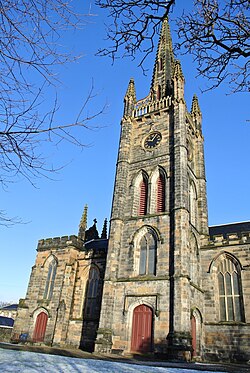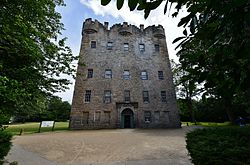Difference between revisions of "Alloa"
(Created page with '{{Infobox town | county=Clackmannanshire | name=Alloa | population=18,989 | census year=2001 | os grid ref=NS900920 | latitude=56.1161 | longitude=-3.7959 | LG district=Clackman…') |
|||
| (2 intermediate revisions by the same user not shown) | |||
| Line 2: | Line 2: | ||
| county=Clackmannanshire | | county=Clackmannanshire | ||
| name=Alloa | | name=Alloa | ||
| + | | picture=St. Mungo's Parish Church Alloa (2).jpg | ||
| + | | picture caption=St Mungo's parish church | ||
| population=18,989 | | population=18,989 | ||
| census year=2001 | | census year=2001 | ||
| Line 13: | Line 15: | ||
| dialling code=01259 | | dialling code=01259 | ||
}} | }} | ||
| + | [[File:ALLOA TOWER MAIN ENTRANCE BUILT IN C14TH.JPG|thumb|250px|Alloa Tower 14th-century main entrance]] | ||
| + | '''Alloa''' is a small town and parish in [[Clackmannanshire]], on the north bank of the [[River Forth]], seven miles east of [[Stirling]]. The town was a burgh of barony, and at one time of considerable commercial importance but is now relatively insignificant. | ||
| − | + | The parish encompasses the adjacent town of [[Tullibody]] and two river islands in the Forth: the [[Alloa Inch]] and [[Tullibody Inch]]. | |
| − | + | ||
| − | + | ||
==Buildings == | ==Buildings == | ||
| − | + | * '''Alloa Tower''' ([[National Trust for Scotland]]) (the surviving part of the ancestral mediæval residence of the Erskine family, the Earls of Mar, with its original mediæval wooden roof and battlements. It is one of the largest and earliest of Scottish tower houses. | |
| − | * '''Alloa Tower''' ([[National Trust for Scotland]]) (the surviving part of the ancestral | + | |
* Alloa Town Hall and Library (1886-9, designed by Alfred Waterhouse.<ref>{{cite web|publisher=Dictionary of Scottish Architects|title =DSA Building/Design Report | url =http://www.codexgeo.co.uk/dsa/building_full.php?id=M024733 | date=2006| accessdate=2008-04-11 }}</ref> | * Alloa Town Hall and Library (1886-9, designed by Alfred Waterhouse.<ref>{{cite web|publisher=Dictionary of Scottish Architects|title =DSA Building/Design Report | url =http://www.codexgeo.co.uk/dsa/building_full.php?id=M024733 | date=2006| accessdate=2008-04-11 }}</ref> | ||
| − | * Older buildings surviving 19th and 20th century "slum-clearance": | + | * Older buildings surviving 19th- and 20th-century "slum-clearance": |
** Tobias Bauchop's House (1695) | ** Tobias Bauchop's House (1695) | ||
| − | ** Inglewood House | + | ** Inglewood House |
**Gean House | **Gean House | ||
| − | **Greenfield House | + | **Greenfield House |
==Churches == | ==Churches == | ||
| Line 43: | Line 44: | ||
==History == | ==History == | ||
| − | |||
| − | |||
During the 18th century, Alloa thrived as a river port through which manufacture from [[Glasgow]] was exported to Europe. At that time, and until the 1950s, the main industry to the north and east of the town was coal mining, and an extensive waggonway existed to take the coal to the harbour. The Earls of Mar owned many of the coal mines, and Robert Bald, an unusually inventive local mining engineer, was instrumental in providing water power from the Gartmorn Dam to operate both the mines and other industries such as weaving. Many traces of the waggonway, and the Gartmorn Dam, can still be seen today, and although the dam is no longer used for energy production, or water supply, it is well used for fishing and leisure purposes. | During the 18th century, Alloa thrived as a river port through which manufacture from [[Glasgow]] was exported to Europe. At that time, and until the 1950s, the main industry to the north and east of the town was coal mining, and an extensive waggonway existed to take the coal to the harbour. The Earls of Mar owned many of the coal mines, and Robert Bald, an unusually inventive local mining engineer, was instrumental in providing water power from the Gartmorn Dam to operate both the mines and other industries such as weaving. Many traces of the waggonway, and the Gartmorn Dam, can still be seen today, and although the dam is no longer used for energy production, or water supply, it is well used for fishing and leisure purposes. | ||
Latest revision as of 19:41, 28 February 2017
| Alloa | |
| Clackmannanshire | |
|---|---|
 St Mungo's parish church | |
| Location | |
| Grid reference: | NS900920 |
| Location: | 56°6’58"N, 3°47’45"W |
| Data | |
| Population: | 18,989 (2001) |
| Post town: | Alloa |
| Postcode: | FK10 |
| Dialling code: | 01259 |
| Local Government | |
| Council: | Clackmannanshire |
| Parliamentary constituency: |
Ochil and South Perthshire |
Alloa is a small town and parish in Clackmannanshire, on the north bank of the River Forth, seven miles east of Stirling. The town was a burgh of barony, and at one time of considerable commercial importance but is now relatively insignificant.
The parish encompasses the adjacent town of Tullibody and two river islands in the Forth: the Alloa Inch and Tullibody Inch.
Buildings
- Alloa Tower (National Trust for Scotland) (the surviving part of the ancestral mediæval residence of the Erskine family, the Earls of Mar, with its original mediæval wooden roof and battlements. It is one of the largest and earliest of Scottish tower houses.
- Alloa Town Hall and Library (1886-9, designed by Alfred Waterhouse.[1]
- Older buildings surviving 19th- and 20th-century "slum-clearance":
- Tobias Bauchop's House (1695)
- Inglewood House
- Gean House
- Greenfield House
Churches
- Church of Scotland:
- St Mungo's Parish Church
- Alloa North Parish Church
- Alloa West Parish Church
- United Free Church of Scotland: Moncrieff U.F. Church in Drysdale Street
- Episciopal Church: St John's Church
- Roman Catholic: St Mungo's
The headquarters of Action of Churches Together in Scotland, the ecumenical organisation linking Scotland's largest churches, is located at Inglewood House, Alloa.
History
During the 18th century, Alloa thrived as a river port through which manufacture from Glasgow was exported to Europe. At that time, and until the 1950s, the main industry to the north and east of the town was coal mining, and an extensive waggonway existed to take the coal to the harbour. The Earls of Mar owned many of the coal mines, and Robert Bald, an unusually inventive local mining engineer, was instrumental in providing water power from the Gartmorn Dam to operate both the mines and other industries such as weaving. Many traces of the waggonway, and the Gartmorn Dam, can still be seen today, and although the dam is no longer used for energy production, or water supply, it is well used for fishing and leisure purposes.
The town itself was known for weaving and glassmaking. Alloa was long associated with the brewing industry too, at least nine major breweries producing ales there. However this industry declined severely during the late 20th century, depressing the town's economy.
References
- ↑ "DSA Building/Design Report". Dictionary of Scottish Architects. 2006. http://www.codexgeo.co.uk/dsa/building_full.php?id=M024733. Retrieved 2008-04-11.
